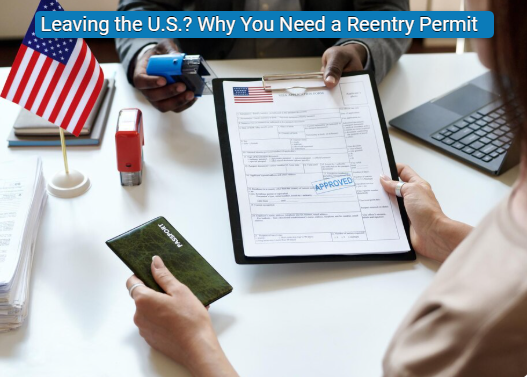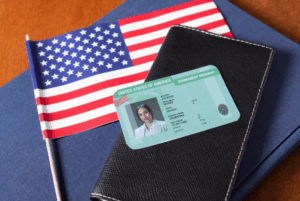Why You Might Need a Reentry Permit
We work with many people who’ve worked hard to get their green cards — people who’ve made the U.S. their home, even if they still have deep ties to another country. And sometimes, life takes them back out of the country — for work, family, school, or something unexpected.
The first thing we always ask in those cases is: How long do you plan to be outside the U.S.? Because here’s the truth, most people don’t realize — if you’re gone too long, you can lose your green card.
That’s why reentry permits exist. And that’s why we’re writing this.
Why It Matters More Than People Think
A lot of folks believe once you have a green card, you’re safe. You can come and go as you please. But that’s not quite true.
If you’re gone for more than six months, you might face challenging questions. If you’re out for more than a year, USCIS can treat your absence as abandonment, like you’ve walked away from your U.S. residence.
It doesn’t matter how valid your reason is. It could be work, a sick parent, an academic program, or even something you didn’t plan. If you didn’t file a reentry permit before you left, you may have a problem when you try to come back.
That’s why we always recommend that if you’re going to be away for a while, apply for a reentry permit in advance. It’s not about red tape — it’s about holding onto what you’ve worked for.
What Is a Reentry Permit?

In plain terms, it’s a travel document that tells the U.S. government you plan to come back. It says: I’m leaving for now, but I’m not giving up my permanent residency.
You file it before you leave, using Form I-131. That’s the U.S. reentry permit application, and it’s the same form used for a few other types of travel documents. In your case, you’d check the box for reentry permits.
Once approved, it allows you to stay abroad for up to two years without being considered to have abandoned your green card.
When You Might Need One (Real Examples)
We’ve helped clients apply for reentry permits in all sorts of situations. Here are a few that come up a lot:
- International job assignment — One of our clients was working with a U.S. company but was stationed in Singapore for 18 months. We filed the reentry permit in advance, and when he came back, he had no issues.
- Family illness abroad — A green card holder we worked with had to care for her father in the Philippines. She was gone for 14 months. Because we helped her get a reentry permit before she left, she returned without losing her status.
- Study abroad — Green card holders pursuing a master’s or PhD outside the U.S. for one or two years need to protect their status. Even if you intend to come back, USCIS needs documentation to prove it.
In all these cases, the reentry permit acted like a promise: “I’ll be back. Just give me time.”
What the Process Looks Like

Here’s how we guide our clients through the reentry permit process. It’s not complicated, but it does have to be done right.
- We prepare Form I-131 — This is your application for the reentry permit. We handle every detail so nothing’s missed.
- You gather supporting documents — This usually includes a copy of your green card, a couple of passport-style photos, and a brief explanation of why you’re leaving and for how long.
- Pay the government fees — The fee for a reentry permit is $630, plus $85 for biometrics if you’re between 14 and 79. That brings your reentry permit cost to $715 in most cases (fees subject to change).
- We apply to USCIS — We make sure it goes to the correct address, depending on your location and mailing method.
- You attend a biometrics appointment — This is key. It’s usually scheduled a few weeks after filing, and it must happen before you leave the U.S. If you miss it or leave early, your application can be denied.
How Long Does It Take?
If you’re wondering how long it takes to apply for a reentry permit, the general processing time is 2 to 6 months on average. In some cases, people receive it in about 90 days. If you’re in a hurry, we can explore whether you qualify for expedited processing — but most people don’t.
So our advice? Don’t wait. File at least three months before you plan to leave.
How Long Is It Valid?
In most cases, a reentry permit is valid for two years from the date it’s issued.
But if you’ve already spent a lot of time outside the U.S. in the past, USCIS might give you a permit that’s only good for one year. They look at your full travel history.
And here’s something that trips people up: you can’t renew or extend your permit while you’re abroad. If it expires and you still need more time outside the U.S., you have to come back, file again, and go through the process all over again.
What Happens If You Don’t Get One?

We’ve worked with clients who didn’t realize they needed a permit and tried to reenter the U.S. after a year or more abroad. Some were sent for secondary inspection. Others had their green cards flagged. A few had to fight to prove they hadn’t given up their residency.
In some cases, people have to apply for something called a returning resident visa, which is extremely difficult to get approved. That’s why we urge green card holders not to take the risk.
Final Thoughts From Our Team
Getting a green card is hard. Keeping it shouldn’t be. That’s our philosophy.
If you’re leaving the U.S. for more than a few months — and especially if you’re planning to be gone more than a year — apply for a reentry permit. Don’t assume the government knows your intentions. Show them. File the paperwork. Protect your status.
If you’re not sure whether you need a reentry permit USA, we can walk you through it. We’ll look at your timeline, your travel history, and your plans, and help you make the best decision.
This is what we do every day at Passage Immigration Law. And we’d be glad to help you next.
Need Help Filing?

We handle reentry permit green card applications from start to finish. No guessing. No stress. Just expert guidance from attorneys who’ve done this hundreds of times.
Ready to protect your status while you’re abroad?
Disclaimer: This article offers general legal information, not legal advice. Do not rely upon this information without seeking legal counsel. If you need legal advice, you may contact us directly to speak with an attorney. We disclaim all liability with respect to actions taken based on any information presented. Every case is different, and outcomes will vary depending on the unique facts and legal issues of your case.







